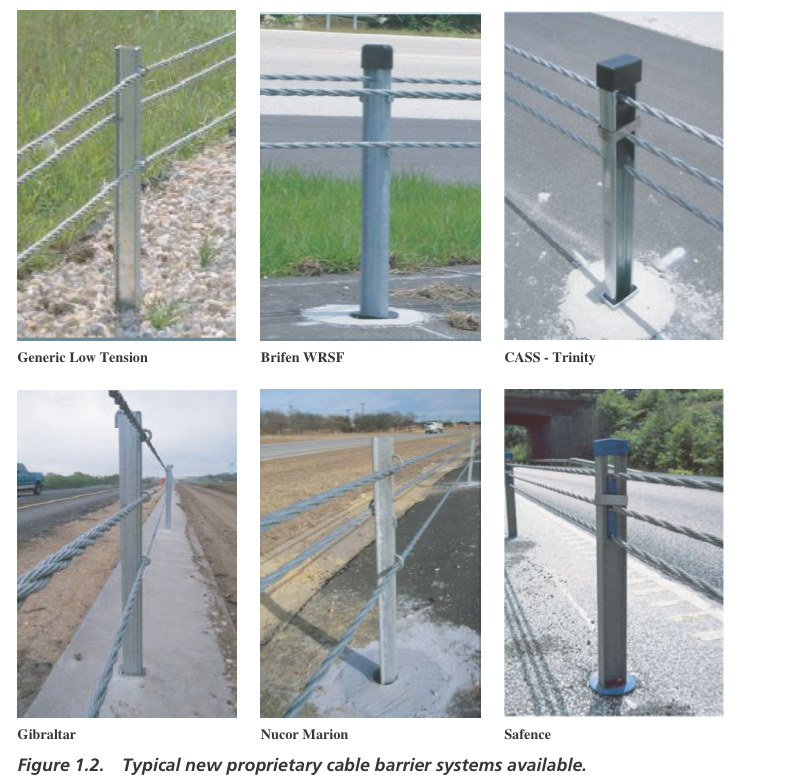NATIONAL COOPERATIVE HIGHWAY RESEARCH PROGRAM
Introduction
Cable barriers are longitudinal roadside devices used to contain and/or redirect errant vehicles that depart the roadways. These barriers gradually redirect or arrest an impacting vehicle by stretching of the cables, minimizing forces on the vehicle and its occupants. While cable barriers have been used on U.S. highways for more than 60 years, their use has been on the rise and is expected to increase in the future. This increase in use is attributed to cable barriers’ success rate in keeping vehicles from crossing the median or leaving the roadway, reduced impact severity, availability of new cable barrier technologies, low initial installation cost, and suitability for various median and roadside environments.
Cable barriers as a roadside device are most suited in locations where there is sufficient space to accommodate the lateral deflections that may occur during crashes. Figure 1.1 shows a generic 3-cable low-tension barrier installed on a divided highway with narrow median and relatively flat side slopes. Such low-tension systems are still in use and continue to be used, but new technologies have led to the development of a host of proprietary cable barrier systems. Figure 1.2 depicts some of these systems. Differences in the number, heights, and arrangement of cables, post types, cable connectors, embedment, and other features are obvious in these pictures. Not so obvious is the difference between the high-tension and low-tension cable systems. Although these systems have been tested to current standards and have been “accepted” for use on U.S. highways, the differences complicate efforts to select a system for a particular application. More specifically, high-tension cable systems, when compared to low-tension systems, have the advantage of lower deflection during impacts and supposedly reduced maintenance costs. These have seen increased usage in many states and hundreds of miles of new installations are added yearly.
Several studies have shown that cable barriers reduce median crossover accidents that could lead to some of the most severe head-on crashes, which are often fatal. Although there is general agreement that cable median barriers are “highly effective” with some reporting success rates higher than 90 percent, there have not been sufficient analyses to establish reliable crash reduction factors. Cable barriers have been noted to function for a wide range of vehicles, including tractor-trailer trucks. There have, however, been problems reported. These have included overrides, underrides, shearing vehicle roof pillars, post fracture, and anchorage failures. The frequency and causes of these occurrences, however, is not fully understood.
The noted occurrence of vehicles underriding the barrier, crossing the median, and penetrating into the opposite traffic lanes has been the impetus for research to identify the cause of the problems and find means to mitigate them. This prompted FHWA to initiate research studies on cable median barriers to identify some of the reasons for median crossovers and to develop design guidelines to optimize the safety performance of cable barriers. In these studies, finite element analyses, vehicle dynamics analyses, and full-scale crash tests were used to assess factors that could influence the effectiveness of cable barriers in redirecting or arresting errant vehicles. These factors included the terrain geometry and shape, speeds and angles of the vehicles as they leave the road, lateral placement of the barrier, barrier system configuration (heights of cables), vehicle type (front geometry and mass), post spacing, and barrier lengths. These efforts provided an explana- tion for the occurrence of underrides and revealed a much stronger relationship between barrier placement and median configuration on barrier effectiveness than had been assumed.
The need to better understand the effectiveness of cable barriers and the influence of factors related to the design of cable barrier systems, the configuration of medians, and the nature of impact conditions prompted an interest in further research. The variety of cable barrier systems available, the inadequacy of past deployment practices for new systems, and the need to establish better guidance to highway engineers provided further stimulus for this research.
About the National Cooperative Highway Research Program
www.trb.org/NCHRP/
“The National Cooperative Highway Research Program (NCHRP) conducts research in problem areas that affect highway planning, design, construction, operation, and maintenance nationwide.”
Tags: NATIONAL COOPERATIVE HIGHWAY RESEARCH PROGRAM, NCHRP, Transportation Research Board, TRB







 RSS Feed
RSS Feed